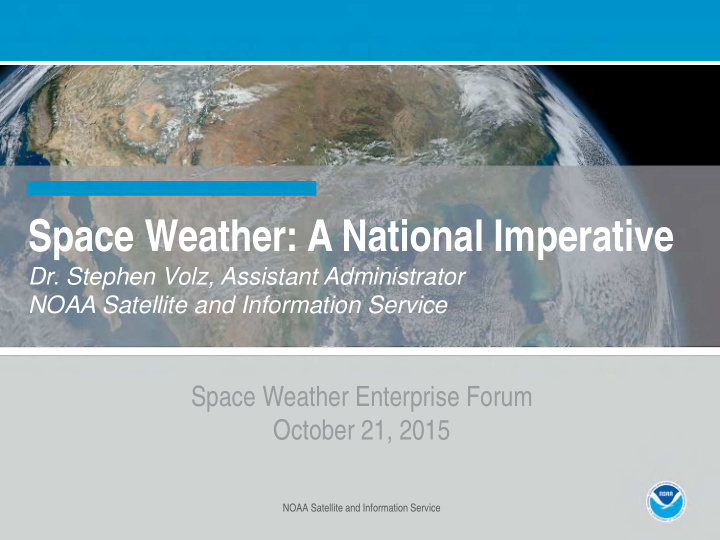



Space Weather: A National Imperative Dr. Stephen Volz, Assistant Administrator NOAA Satellite and Information Service Space Weather Enterprise Forum October 21, 2015 NOAA Satellite and Information Service
Outline • The Imperative • Overview of NOAA’s Role • Where We Are Now • Global space weather observing system • Looking to the Future • New Administration commitment • New observations, models, and products • Planning for future observations 2
The Imperative • Space Weather impacts a wide variety of critical infrastructure elements • Electrical power transmission • Air and Space transportation • Satellite operation • Space-Based Positioning, Navigation, and Timing (e.g. GPS) • Pipelines • Railways • Serious impacts to health, governance, and the economy could result from an extreme space weather event • 1989 Quebec 9-hour blackout: >$500M impact • 2003 NYC 24-hour blackout: 100 fatalities 3
NOAA’s Role: Operational Space Weather System NASA’s ACE NWS Space Weather Prediction Center NASA’s SDO DSCOVR GOES NASA’s SOHO Multiple ground-based observatories Real-Time Solar Wind Network: Germany, Korea, Japan, U.S. 4
NOAA’s Role: Building a Weather Ready Nation • NWS imperative: protect life & property while enhancing commerce • NWS strategic outcome: “Ready, responsive, resilient” • Extreme weather events arena remains the focus • “Impact-based Decision Support Services” (IDSS) tailored to specific areas such as space weather 5
NOAA’s Role: Reaching Users SWPC customers currently include: • Electric utilities • Banking 140 52000 • Emergency 48000 120 44000 response 40000 100 • Shipping 36000 Sunspot Number 32000 Number of Customers 80 • Aviation 28000 24000 • Precision 60 20000 agriculture 16000 40 12000 • Surveying 8000 20 • Oil drilling 4000 0 0 • Satellite operators Customers Solar Cycle 6
Where We Are Now 7
Global Space Weather Observing System: Interagency Partnerships • Both NASA research and NOAA operational assets support NOAA’s space weather forecasting mission • SWPC uses U.S. Air Force contributions operationally – Including both data from USAF ground networks of optical and radio telescopes and USAF models • Complementary research and operational flight opportunities exist – NOAA will coordinate with NASA Heliophysics regarding the potential use of future operational platform(s) to meet some of both agencies’ objectives • Development of new technologies will advance space weather forecasting capabilities – NOAA will continue to work with NASA Heliophysics and Space Technologies Mission Directorate on new sensors and new technologies 8
Global Space Weather Observing System: International Partnerships & the RTSW Network Real-Time Solar Wind Network (RTSW) Germany: DLR Korea: KSWC Japan: NICT US: NOAA RTSW: DLR RTSW: NOAA RTSW: NICT RTSW: RTSW: KSWC NOAA 9
Global Space Weather Observing System: International Partnerships Collaboration on Space Weather Forecasting and Services 10
Looking to the Future 11
New Administration Commitment 12
New NOAA Observational Assets NOAA DSCOVR At L1 as of June 8, 2015 NOAA GOES-R Launching in late 2016 COSMIC-2 Launching 2016–2019 13
New Models and Products Highlight: Geospace Model of Earth’s Magnetosphere • Developed in collaboration with U. Michigan and NASA/CCMC. • Driven by solar wind data from DSCOVR • Provides regional magnetic field changes • Enables GIC predictions and regional products for the electric power industry SWMF Geospace Model: Product showing the change in magnetic field across North America • Solar Wind DSCOVR Magnetosphere 22-23 June 2015 14
Future Observations Planning • Space Weather Follow-on plan will provide continuity and improve on DSCOVR observations – Details of implementation will be driven by NESDIS architecture studies • Key new observation will be coronagraph images from the sun- earth line • NOAA will be coordinating with international partners as well on possible missions to explore options to improve the observing system – Such as off-sun-earth angle coronagraph images from L5 to continue STEREO improvements to forecasting. 15
National Attention to Space Weather • 2008, Severe Space Weather Events: Understanding Societal and Economic Impacts: A Workshop Report, National Academies Press. • 2013, FERC Order 779 to electric power transmission operators: GMD protection mandate. • 2015, House Resolution 1073: Critical Infrastructure Protection Act includes space weather threats. • 2015, DHS Strategic National Risk Assessment includes space weather threats. • 2015, OSTP National Space Weather Strategy and Action Plan. 16
The Imperative Revisited 1859 2012 Credit: ESA&NASA/SOHO Credit: Originally published by the British Royal Astronomical Society; provided by the NASA Astrophysics Data System. Will we be ready? 17
Recommend
More recommend